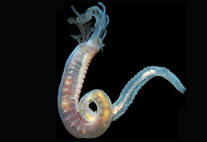Abstract
This paper describes the hitherto unknown larva of Apatania helvetica Schmid 1954. Sequence data from the mitochondrial cytochrome c oxidase region were used to associate adult females and larvae. Genetic data confirmed the autochthonous status of this taxon within the parthenogenetic Apatania muliebris Complex (‘sous groupe’) sensu Schmid 1954. Information on the morphology of the larva is given, and the most important diagnostic features are illustrated. Apatania helvetica is morphologically close to Apatania muliebris McLachlan 1866 and A. fimbriata (Pictet 1834). In the context of Apataniidae, this trio of species can be separated by the presence of long tapering setae with flexible tips at the anterior border of the pronotum, by a central gap within the transverse setal band on the 1st abdominal dorsum, by biometry of the frontoclypeal setation and by their distribution in Europe. With respect to European ecoregions (Graf et al. 2008), Apatania muliebris has been recorded from the Alps, the central plains and highlands, the Baltic countries, Great Britain, Ireland and Scandinavia; A. fimbriata is known from the Alps, the western and central highlands, the western plains, the Hungarian lowlands and the Carpathians; and A. helvetica is restricted to the Alps and has been recorded only in Switzerland.

